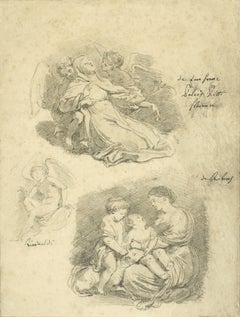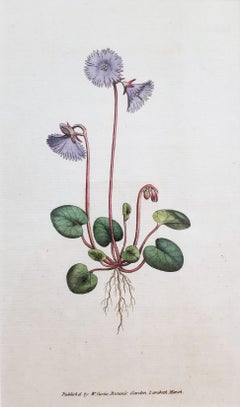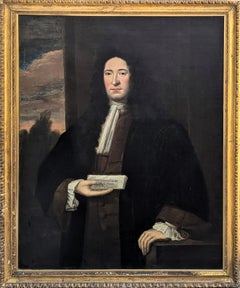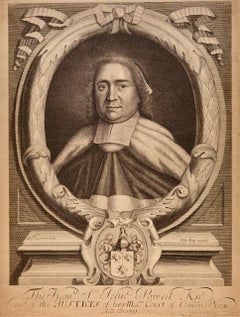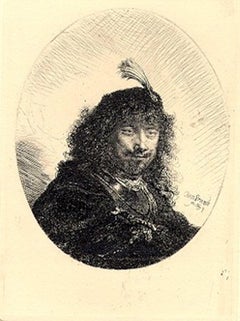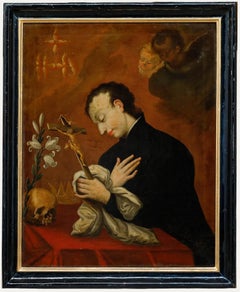18th Century Art
to
573
3,373
1,086
376
241
301
Overall Width
to
Overall Height
to
7,534
21,272
158,709
232,783
1,969
2,236
4,911
6,412
5,806
13,276
19,657
25,624
18,277
13,568
5,378
2,282
1,164
42
15
8
2
1
2,726
2,166
370
3,159
1,575
1,077
901
850
705
613
442
414
382
318
271
256
186
170
155
143
127
124
119
3,178
1,226
895
775
455
160
127
86
81
72
1,231
3,066
3,381
838
Period: 18th Century
Three studies executed in the Pitti Palace in 1761 by Jean-Honoré Fragonard
Located in PARIS, FR
This brilliant study sheet, of which we present here a counterproof, is a souvenir of Fragonard's return journey from Italy. Between April and September 1761, he accompanied the abbot of Saint-Non on his way back to France. Three studies after the masters taken from the Pitti Palace’s gallery in Florence are gathered on this sheet. Although The Ecstasy of Saint Margaret...
Category
Old Masters 18th Century Art
Materials
Carbon Pencil
Soldanella Alpina Alpine Soldanella /// English Botanical Flower Engraving Print
Located in Saint Augustine, FL
Artist: William Curtis (English, 1746-1799)
Title: "Soldanella Alpina Alpine Soldanella" (Vol. 2, Plate 49)
Portfolio: The Botanical Magazine; or, Flower-Garden Displayed
Year: 1788 ...
Category
Victorian 18th Century Art
Materials
Watercolor, Laid Paper, Engraving, Intaglio
Early Historical Portrait Believed to be of Scottish Politician David Carnegie
By John Baptist De Medina
Located in Houston, TX
Early historical portrait in the style of William Aikman believed to be of David Carnegie, 4th Earl of Northesk, a Scottish peer and politician. The work features the central figure ...
Category
Old Masters 18th Century Art
Materials
Canvas, Oil
Sir. John Powell, Knight: Early 18th C. Engraved Portrait After William Sherwin
Located in Alamo, CA
This is an early 18th century portrait of Sir John Powell entitled "The Honorable Sr. John Powell, Knight. one of the Justices of her Majesties' Court of Common Pleas. Ano. D 1711". It was engraved and published by John King in London in 1711, after an earlier work by William Sherwin. The engraving depicts a bust length portrait of Powell wearing an elaborate fir-trimmed robe and collar. The portrait is encompassed in an ornate oval frame, sitting on a pedestal with an impressive coat-of-arms below.
This engraved portrait is printed on laid, chain-linked watermarked cream-colored paper The sheet measures 15.25" high and 11.38" wide. It is adhered to an archival thick card at the upper corners, There is a 1/8" tear at the lower edge of the sheet, but the print is otherwise in very good condition. This engraving is held by museums and institutions, including the British Museum and the Harvard University Art Museum.
Sir John Powell (1632-1696) was an English lawyer and judge who served as a justice of the King's Bench from 1683 until his death. He was born in Glamorganshire, Wales, and studied at Jesus College, Oxford, before being called to the bar at the Middle Temple in 1656. Powell was known for his staunch support of the monarchy and the Church of England, and he played a prominent role in the trial of the Whig leader Lord William Russell in 1683, which resulted in Russell's execution for his alleged involvement in a plot to assassinate King Charles II. Powell was also involved in the trials of several other prominent Whig politicians, including Algernon Sidney and Titus Oates. In addition to his work as a judge, Powell was also a member of Parliament for various constituencies throughout his career, and he served as Solicitor General and Attorney General for Wales under King James II. However, he opposed James's efforts to promote Catholicism and supported the Glorious Revolution of 1688, which led to James's overthrow and the installation of William and Mary as joint monarchs.
Powell was known for his intellectual rigor and his legal expertise, and he authored several influential legal treatises during his lifetime. He was widely respected by his peers and by the legal community as a whole, and his legacy as a jurist and judge continues to be celebrated today.
William Sherwin (1645-1709) was an English engraver who worked during the late 17th and early 18th centuries. He was born in Chesterfield, Derbyshire, and is known for his high-quality engravings of various subjects, including portraits, landscapes, and architectural views. Sherwin was trained as an engraver and worked as an apprentice to the renowned engraver Robert White. After completing his training, he went on to establish his own studio in London, where he produced a significant body of work over the course of his career. One of Sherwin's most famous works is his engraving of the portrait of John Locke...
Category
Old Masters 18th Century Art
Materials
Engraving
Self-Portrait, Etching by Rembrandt van Rijn
Located in Long Island City, NY
Rembrandt van Rijn, After by Amand Durand, Dutch (1606 - 1669) - Self-Portrait, Year: of Original: 1634, Medium: Etching, Image Size: 5.5 x 4.5 inches, Size: 14 x 11 in. (35.56 x ...
Category
18th Century Art
Materials
Etching
18th Century Oil - Saint Aloysius Gonzaga
Located in Corsham, GB
An evocative 18th-century religious oil painting rich in symbolism, portraying Saint Aloysius Gonzaga. The saint is represented through traditional iconography: a lily symbolising pu...
Category
18th Century Art
Materials
Oil
18th Century Oil on Canvas Spanish Religious Painting Virgin with Christ, 1750
Located in Vicoforte, IT
Antique Spanish painting from 18th century. Framework oil on canvas depicting a religious subject Piety, Virgin with deposed Christ, of good pictorial quality. Large size and impact ...
Category
18th Century Art
Materials
Canvas, Oil
Mejor es Holgar from Los Caprichos - Etching by Francisco Goya - 1799
Located in Roma, IT
Mejor es holgar from Los Caprichos is an original artwork realized by the artist Francisco Goya and published for the first time in 1799.
Etching and a...
Category
Modern 18th Century Art
Materials
Etching, Aquatint
Skeleton after Titian - Etching by Jean François Poletnich - 1755
Located in Roma, IT
Skeleton after Titian is an etching realized by Jean Francois Poletnich in 1755.
Signed in the plate.
Good conditions with foxing.
The artwork is depicted through confident stroke...
Category
Modern 18th Century Art
Materials
Etching
English 18th century portrait of Henrietta Pelham-Holles, Duchess of Newcastle.
Located in Bath, Somerset
Portrait of Henrietta Pelham-Holles (née Godolphin) (1701-1776), Duchess of Newcastle, standing in a wooded landscape with a river beyond, three-quarter length wearing an ivory silk ...
Category
Old Masters 18th Century Art
Materials
Canvas, Oil
Escuela colonial (XVIII) - Óleo en tela - La enseñanza de santa Ana a la virgen
Located in Sant Celoni, ES
La obra se presenta enmarcada con su marco original de la época (el marco presenta faltas y desgastes)
El estado de la obra se puede ver, tiene perdidas y de pintura y faltas en la ...
Category
Old Masters 18th Century Art
Materials
Oil
The Original Entrance to the Cloisters at Magdalen College, Oxford Engraving
Located in London, GB
To see our other views of Oxford and Cambridge, scroll down to "More from this Seller" and below it click on "See all from this seller" - or send us a message...
Category
Realist 18th Century Art
Materials
Engraving
Giuseppe Zais (Venetian master) - 18th century landscape painting - Figures
By Giuseppe Zais (Canale d'Agordo, Belluno 1709 - Treviso 1781)
Located in Varmo, IT
Giuseppe Zais (Forno di Canale 1709 - Treviso 1784) - Landscape with shepherds and spinner.
48 x 63.5 cm without frame, 59 x 74.5 cm with frame.
Oil on canvas, in a carved and gild...
Category
Rococo 18th Century Art
Materials
Canvas, Oil
Fine 18th Century Old Master Oil Painting Dead Game in Landscape
Located in Cirencester, Gloucestershire
Still Life with Dead Birds
18th Century Italian School
oil painting on canvas, framed
framed: 17 x 21 inches
canvas: 14 x 18 inches
provenance: private collec...
Category
Old Masters 18th Century Art
Materials
Oil
An Elegant Hawking Party, A Pair of Paintings
By August Querfurt
Located in Wiscasett, ME
A pair of old master paintings by August Querfurt (1696-1761). Oil on panel, one signed with initials in the lower left. Two scenes depicting hawking parties from the 18th century. I...
Category
Old Masters 18th Century Art
Materials
Oil
18th Century Italian Carved Neoclassical Semi Nude Female Busts
Located in Beachwood, OH
18th Century Italian Carved Neoclassical Semi Nude Female Busts
Wood affixed to wood plinths
"Leone Della Torra / Italy Country of Origin" labels on b...
Category
Italian School 18th Century Art
Materials
Wood
Female Nude in Front of a Curtain with Clothes - Oil on Canvas - 18th Century
Located in Roma, IT
Female nude in front of a curtain with clothes is an old master artwork realized by an Italian artist in the early 18th century,
Mixed colored oil on canvas.
Good condition.
Category
Modern 18th Century Art
Materials
Oil
$8,526 Sale Price
25% Off
Sandwich Islands Canoe (Hawaii): Framed 18th C. Engraving Captain Cook's Journal
By John Webber
Located in Alamo, CA
"A Canoe of the Sandwich Islands, the Rowers Masked" is an engraving created by Charles Grignion, from a drawing by John Webber (1752-1793), who was the artist on Captain James Cook's 3rd and final voyage of discovery. It is Plate 65 in the atlas of "A Voyage to the Pacific Ocean Undertaken by the Command of His Majesty, for Making Discoveries in the Northern Hemisphere", the official British Admiralty sanctioned journal published upon completion of the voyage in London in 1784 by Strahan & Cadell.
This famous image of ten Hawaiian rowers transporting a priest who is carrying a feather-covered image of Kukailimoku, the Hawaiian god of war. The priests and paddlers are all wearing gourd masks in their double-hulled canoe with an upright lateen woven sail. Each hull was shaped from a single large Koa log harvested from island rainforests, where they were carved before being transported to the coast.
This engraving is presented in a Koa wood frame and a white mat. There are occasional faint spots, but the print is otherwise in very good condition. Koa is the same wood as was used to make the canoe. Koa wood is legendary in Hawaii. Not only is this amazing wood native to Hawaii, but it is known for the deep rich colors and varied grain pattern. Koa has an honored heritage in Hawaii and is highly revered and sacred. The word “koa” means “warrior” in Hawaiian. The warriors of King Kamehameha the Great, created canoes and weapons from a wood plentiful on the Big Island of Hawaii. This wood became synonymous with the warriors themselves, and it became known as koa. The frame measures 20.75" high, 26.75" wide and 0.88" deep.
There are three other engravings listed from the official journal of Captain Cook's 3rd voyage available that are presented in identical Koa wood frames and mat (LU117324682022, LU117324684052, LU117324684062). They would make a wonderful grouping for a display of 2, 3 or 4 prints. A discount is available for a grouping depending on the number of items included.
Hawaii was discovered by Captain Cook (1728-1779) during this voyage. Hawaii was originally called The Sandwich Islands in honor of The Earl of Sandwich...
Category
18th Century Art
Materials
Engraving
Four Koa Wood Framed 18th C. Engravings from Captain Cook's 3rd Voyage Journal
By John Webber
Located in Alamo, CA
A grouping of four framed engravings of Hawaii, Tahiti, Tonga and Vancouver Island from the atlas of the official British Admiralty sanctioned journal of Captain Cook's 3rd Voyage entitled "A Voyage to the Pacific Ocean Undertaken by the Command of His Majesty, for Making Discoveries in the Northern Hemisphere", published upon completion of the voyage in London in 1784 by Strahan & Cadell. These engravings were made from drawings by John Webber (1752-1793), who was the artist on Captain James Cook's 3rd and final voyage of discovery. The set of engravings includes: "A Canoe of the Sandwich Islands, the Rowers Masked", Plate 65 in the atlas; "A Dance in Otaheite" (Tahiti), Plate 28; "King of the Friendly Islands" (Tonga), plate 20; "Inside of a House in Nootka Sound" (Canada), plate 42.
These engravings are professionally framed in Koa wood, the same wood as was used to make the canoes of the ancient Hawaiians. Koa wood is legendary in Hawaii. Not only is this amazing wood native to Hawaii, but it is known for the deep rich colors and varied grain pattern. Koa has an honored heritage in Hawaii and is highly revered and sacred. The word “koa” means “warrior” in Hawaiian. The warriors of King Kamehameha the Great, created canoes and weapons from a wood plentiful on the Big Island of Hawaii. This wood became synonymous with the warriors themselves, and it became known as koa.
These four engravings would make a wonderful grouping for a display of 2, 3 or 4 prints. They may be purchased separately or in groups on 1stDibs. Their listing Reference #'s are: LU117324682432, LU117324682022, LU117324684052 and LU117324684062. A discount is available for a grouping depending on the number of items included.
Hawaii was discovered by Captain Cook (1728-1779) during this voyage. Hawaii was originally called The Sandwich Islands in honor of The Earl of Sandwich...
Category
Other Art Style 18th Century Art
Materials
Engraving
$7,660 Sale Price
20% Off
Piranesi Etching of Hadrian's Ancient Roman Aqueduct and Baths, "Aquae Virginis"
Located in Alamo, CA
This is a framed Giovanni Battista Piranesi (1720-1778) etching entitled "Orthographia utriusque lateris arcuum ductus Aquae Virginis a specu principe ad Hadriani thermas, effossorum...
Category
Old Masters 18th Century Art
Materials
Etching
"Lute Player" 18th Century Dutch School, Signed oil on panel
Located in New York, NY
Dutch School
Late 18th century
Oil on panel
6 1/4 inches x 5 1/2 inches (15.9 x 14 cm)
Framed: 14 x 12 inches (35.5 x 30.5 cm)
Signed lower right
This delightful study of a lute pl...
Category
Dutch School 18th Century Art
Materials
Oil, Panel
Large Chrysanthemum Carved Lacquer Box
Located in Taichung, TW
This Large Chrysanthemum Carved Lacquer Box by Chen Wu is an Edo-period example of Kamakura-bori lacquerware. Built on a solid wooden core, it is finished with layers of dark lacquer...
Category
Other Art Style 18th Century Art
Materials
Lacquer, Wood
Thisbe and Pyramus, Ovid's Metamorphoses, French Classical Myth engraving, 1768
Located in Melbourne, Victoria
Copper-line engraving by Nicolas de Launay after Charles Monnet (1732-1808).
Thisbe, finding the dead body of Pyramus, throws herself on a sword.
Fro...
Category
Naturalistic 18th Century Art
Materials
Engraving
Flowering Sweet Pea: 18th Century Hand-colored Botanical Engraving by Weinmann
Located in Alamo, CA
This is an original antique colored botanical mezzotint and line engraving of flowering Red Sweet Peas which is finished with hand-coloring. It is entitled "Lathyrus Flore Majore Pur...
Category
Naturalistic 18th Century Art
Materials
Engraving, Mezzotint
Ancient Roman Statue - Original Etching by Carlo Nolli - 18th Century
By Carlo Nolli
Located in Roma, IT
Ancient Roman Statue, from the series "Antiquities of Herculaneum", is an original etching on paper realized by Carlo Nolli in the 18th century.
Signed on the plate, on the lower ri...
Category
Old Masters 18th Century Art
Materials
Etching
35. Common hyacinth, Common tiger, moth
Located in Columbia, MO
Maria Sibylla Merian was born in Germany in 1647 and received early artistic training from her stepfather, an established still life painter. She was fascinated by insects and collec...
Category
Realist 18th Century Art
Materials
Pigment
18th Century by Giovanni Crivelli Still life with dog and game Oil on canvas
Located in Milano, Lombardia
Giovanni Crivelli, known as Il Crivellino (Milan? Italy, 1680/90 - Parma, Italy, 1760)
Title: Still life with dog and game in a rural landscape
Medium: Oil on canvas
Dimensions: with...
Category
Old Masters 18th Century Art
Materials
Canvas, Oil
Theseus and Achelous, Ovid's Metamorphoses, French Classical engraving, 1768
Located in Melbourne, Victoria
Copper-line engraving by Massard after Charles Monnet (1732-1808).
Theseus returns from the Calydonian hunt and is met by the river god Achelous.
From...
Category
Naturalistic 18th Century Art
Materials
Engraving
Ancient Roman Fresco/Naval Battle - Original Etching by V. Aloja - 18th Century
Located in Roma, IT
Ancient Roman Fresco / Naval Battle from the series "Antiquities of Herculaneum", is an original etching on paper realized by Vincenzo Aloja in the 18th Century.
Signed on the plat...
Category
Old Masters 18th Century Art
Materials
Etching
Woodpeckers "Le Petit Pic" An 18th Century Hand-colored Engraving by Martinet
Located in Alamo, CA
This is a hand-colored engraving of male and female woodpeckers entitled "1. Le Petit Pie varie, 2. Sa Femelle" by Francois Nicolas Martinet, plate 598 from 'Histoire Naturelle des O...
Category
Naturalistic 18th Century Art
Materials
Engraving
Brown Pelican: An Original Audubon 1st Edition Hand-colored Bird Lithograph
Located in Alamo, CA
This is an original rare and extremely collectible first octavo edition John James Audubon hand colored lithograph entitled "Brown Pelican, Young First Winter", No. 85, Plate 424, fr...
Category
Naturalistic 18th Century Art
Materials
Lithograph
Framed 18th Century Pen and Ink Drawings - Designs for Capital & Base Supports
Located in Corsham, GB
Framed 18th-century pen and ink drawings of elaborate capital and base supports, inspired by Ancient Greek architecture and design. Well presented in a fluted gilt-effect frame. Unsi...
Category
18th Century Art
Materials
Pen
The Donkey - Etching by Pierre Charles Baquoy - 1771
Located in Roma, IT
The donkey is an etching realized by Pierre Charles Baquoy in 1771.
It belongs to the suite "Histoire naturelle, générale et particulière avec la description du Cabinet du Roi".
Pa...
Category
Modern 18th Century Art
Materials
Etching
Escuela Colonial - Óleo sobre cristal - Virgen con niño.
Located in Sant Celoni, ES
Muy interesante ÓLEO SOBRE CRISTAL, representando a una Virgen con Niño, de finales del siglo XVIII principios del XIX.
Escuela colonial, va con un fino marco de madera dorada al oro...
Category
Old Masters 18th Century Art
Materials
Oil
Flowering Hyacinth & Calla Plants: A Besler Hand-colored Botanical Engraving
Located in Alamo, CA
This is a hand-colored copper plate engraving depicting flowering "Hyacinthus Comosus Spurius" (Hyacinth), "Hyacinthus Anglicus" (Blue Hyacinth), "Palma ...
Category
Academic 18th Century Art
Materials
Engraving
Mary, Mother of God, Italian Master circa 1780, Carved Wood, slightly damaged
Located in Eltville am Rhein, DE
Madonna, Mary Mother of God
Italy, circa 1780
Linden wood, painted/gilded
Dimensions: 80 x 32 x 24 cm
Painting/gilding damaged in places
Authenticity guaranteed in writing
Category
Baroque 18th Century Art
Materials
Wood
18th century oil painting English portrait of a gent in armor, wearing a wig
By studio of Sir Godfrey Kneller
Located in Woodbury, CT
Outstanding early 18th century English portrait of James Bellevue.
The portrait was always believed to be the work of Sir Godfrey Kneller who was known to have painted James Bellevu...
Category
Old Masters 18th Century Art
Materials
Canvas, Oil
Animated harbor scene
Located in Genève, GE
Work on canvas
Black wooden frame
71 x 91 x 3 cm
Category
Old Masters 18th Century Art
Materials
Oil
$3,554
St. Paul shaking off the Viper in the Island of Malta
By Giovanni Paolo Panini
Located in London, GB
Literature:
cf. 'Catalogue of Paintings in the Wellington Museum Apsley House' by C.M. Kauffman, revised by Susan Jenkins, English Heritage in association with Paul Holberton publish...
Category
18th Century Art
Materials
Canvas, Oil
Still Life Garland of Flowers - Flemish 18thC art Old Master floral oil painting
By Pieter Casteels III
Located in Hagley, England
This superb 18th century Old Master floral still life oil painting is attributed to Flemish artist Pieter Casteels III. Painted circa 1730 it is a garland or swag of flowers, somethi...
Category
Old Masters 18th Century Art
Materials
Oil
$19,620 Sale Price
20% Off
"Scena alegorica"
Located in Edinburgh, GB
"Scena Allegorica"
Copy after a Venetian 16th century masterpiece by Veronese
Medium: Oil on canvas
Dimensions (Framed): 97 x 107 cm
Dimensions (Canvas): 91 x 100 cm
Signature: Upper right corner
This copy after a Venetian 16th century masterpiece by Veronese, exquisite 19th-century oil painting by Antonio Franchini...
Category
Realist 18th Century Art
Materials
Canvas, Oil
Escuela española (XVIII) - Óleo sobre cobre - Virgen orando
Located in Sant Celoni, ES
La pintura representa a la Virgen María por su iconografía tradicional. Viste un manto azul verdoso que cubre su cabeza y hombros, y una túnica rosada con detalles en tonos claros. S...
Category
Old Masters 18th Century Art
Materials
Oil
Bronze bust of Seneca or Pseudo-Seneca Italy Naples late 18th-early 19th cent
Located in Pistoia, IT
Bronze bust with brown patina depicting the pseudo-Seneca, Italy, early 19th century.
The Pseudo-Seneca is a Roman bronze bust from the late 1st century B.C.. discovered in 1754 in ...
Category
Italian School 18th Century Art
Materials
Marble, Bronze
ANTIQUE FRENCH GILT BRONZE FIGURE OF MARS
Located in Milan, IT
BRONZE FIGURE OF MARS, 18th Century
gilt bronze on marble base
35.6 x 8.9 x 7.6 cm
14 x 3 1/2 x 3 in
Category
18th Century Art
Materials
Marble, Bronze
Cliveden spring, Bucks, Thames, late 18th century English sepia aquatint, 1799
Located in Melbourne, Victoria
'Cliveden Spring, Bucks'
Aquatint published by Samuel Ireland. From his 'Picturesque Views on the River Thames'. Ireland was an author and engraver who published several series of a...
Category
Naturalistic 18th Century Art
Materials
Engraving, Etching, Aquatint
Portrait of Ann Austen, nee Grey
Located in London, GB
Signed 'BDandridge/ pinxit' lower left
Provenance
By descent through the sitter's family to
The Collection of R. W. Vivian-Neal of Poundisford Park, Somerset, from whom acquired by
With Lane Fine Art, UK, where purchased by the present owners in 1996
Literature
'Poundisford Park, Somerset' in Country Life, 22 December 1934, ill.
A.W. and C.M. Vivian-Neal, Poundisford Park, Somerset: A catalogue of pictures and furniture, Taunton 1939, cat. nos. 11 and 13
This is a portrait of Ann Austen, nee Grey, three-quarter-length seated in a landscape with her dog. Painted in a superb white satin dress, she holds horn spectacles and a spectacle case...
Category
English School 18th Century Art
Materials
Oil
Flowering Bardana Daisy: 18th Century Hand-colored Weinmann Botanical Engraving
Located in Alamo, CA
This hand-colored botanical mezzotint and line engraving by Johann Wilhelm Weinmann (1683-1741) is entitled "A. Bardana Major Folio Non Serrato, Napoliere, B. Bdellifera Arbor, de Qu...
Category
Naturalistic 18th Century Art
Materials
Engraving, Mezzotint
Ya es hora from Los Caprichos - Etching by Francisco Goya - 1878
Located in Roma, IT
Ya es hora from Los Caprichos is an original artwork realized by the artist Francisco Goya and published for the first time in 1799.
Etching and aquatin...
Category
Modern 18th Century Art
Materials
Etching
Apollo God With his Lyre - Etching by Pietro Campana - 18th Century
Located in Roma, IT
Apollo God With his Lyre from "Antiquities of Herculaneum" is an etching on paper realized by Pietro Campana in the 18th Century.
Signed on the plate.
Goo...
Category
Old Masters 18th Century Art
Materials
Etching
Portrait of a Lady with a Blue Bow - British 18thC art Old Master oil painting
Located in Hagley, England
This superb British 18th century Old Master portrait oil painting is attributed to Matthew William Peters. Painted circa 1780 it is a fine half length portrait of a woman gazing to her left. She has a lovely blue bow and sash on her dress. The sympathetic detail in her face is sublime. A really wonderful 18th century Old Master portrait. Matthew William Peters was known for his late 18th century portraits which had both the influence of Sir Joshua Reynolds and Thomas Gainsborough.
Provenance. Lincolnshire estate.
Condition. Oil on canvas 30 inches by 25 inches unframed and in good condition. Has has restoration.
Frame. Housed in an ornate gilt carved swept period frame, 40 inches by 35 inches framed and in good condition.
Matthew William Peters (1742-1814) was an English portrait and genre painter who later became an Anglican clergyman and chaplain to George IV. He became known as "William" when he started signing his works as "W. Peters". Peters was born in Freshwater, Isle of Wight, the son of Matthew Peters (born at Belfast, 1711), a civil engineer and member of the Royal Dublin Society; by Elizabeth, the eldest daughter of George Younge of Dublin. The family moved from England to Dublin when Peters was young. Peters received his artistic training from Robert West in Dublin; in 1756 and 1758 he received prizes from the first School of Design in Dublin. In 1759, he was sent by the Dublin Society to London to become a student of Thomas Hudson and won a premium from the Society of Arts. The group also paid for him to travel to Italy to study art from 1761 to 1765. On 23 September 1762 he was elected to the Accademia del Disegno in Florence. Peters returned to England in 1765 and exhibited works at the Society of Artists from 1766 to 1769. Beginning in 1769, Peters exhibited works at the Royal Academy. In 1771 he was elected an associate and in 1777 an academician. He returned to Italy in 1771 and stayed until 1775. He also probably traveled to Paris in 1783–84, where he met Léopold Boilly, Antoine Vestier, and was influenced by the work of Jean-Baptiste Greuze. On 27 February 1769, Peters became a freemason, and he was made the grand portrait painter of the Freemasons and the first provincial grand master of Lincolnshire in 1792. In 1785, he exhibited portraits of the Duke of Manchester and Lord Petre as Grand Master at the Royal Academy exhibition. According to Robin Simon's article in the Oxford Dictionary of National Biography, no British contemporary had such an Italian manner of painting as Peters, reflecting the old masters he copied. Many of Peters' works were erotic and although these works did not damage his career, according to Simon, Peters later regretted these when he became an ordained clergyman in 1781. He served as the Royal Academy's chaplain from 1784 to 1788, at which time he resigned to become chaplain to the Prince of Wales. In 1784, Peters was awarded the living of Scalford, Leicestershire by Charles Manners, 4th Duke of Rutland. In 1788, the Dowager Duchess gave him the living at Knipton, at which time he also obtained that at Woolsthorpe. These livings were near to Belvoir Castle...
Category
Old Masters 18th Century Art
Materials
Oil
$6,758 Sale Price
20% Off
Les Adieux d'Hector d'Andromaque - Etching by Jean Moyreau - 18th Century
By Jean Moyreau
Located in Roma, IT
Les Adieux d'Hector d'Andromaque is an etching realized by Jean Moyreau in the 18th Century.
Good conditions.
The artwork is depicted through soft strokes in a well balanced condit...
Category
Old Masters 18th Century Art
Materials
Etching
Pair of Royal Portraits of the Duke and Duchess of Burgundy
By Pierre Gobert
Located in New Orleans, LA
Follower of Pierre Gobert
18th century French
The Duke and Duchess of Burgundy
Oil on canvas
Refinement and intricacy characterize these royal portra...
Category
18th Century Art
Materials
Canvas, Oil
Letter S - Etching by Luigi Vanvitelli - 18th Century
Located in Roma, IT
Letter S is an Etching realized by Luigi Vanvitelli.
The etching belongs to the print suite “Antiquities of Herculaneum Exposed” (original title: “Le Antichità di Ercolano Esposte”)...
Category
Old Masters 18th Century Art
Materials
Etching
Mother of Pearl Inlaid Wooden Occasional Table
Located in New York, NY
This occasional table is a remarkable example of the luxurious furniture popular during the 17th and 18th centuries in Colonial Latin America. The decorative technique that creates s...
Category
18th Century Art
Materials
Wood
Young girl in pink toilet
Located in Genève, GE
Work on canvas
Category
18th Century Art
Materials
Oil
Portrait of a Lady
By Francesco Guardi
Located in Paris, Île-de-France
Francesco GUARDI (1712-1793)
Portrait of a Lady
Oil on copper
5 1/8 x 4 3/8 in
13 x 11 cm
Unsigned
Provenance
Private collection, France
We are pleased to present an exceptional...
Category
Old Masters 18th Century Art
Materials
Copper
Manner of Francois Boucher (1703-1770) - Pastel, A Moment of Romance
Located in Corsham, GB
A romantic late 18th century pastel rendered in the manner of Francois Boucher (1703-1770), portraying two lovers tenderly embracing in a moonlit forest. Beside them, their loyal dog...
Category
18th Century Art
Materials
Pastel
Allegory Of Europe Solimena 18th Century Paint Oil on canvas Old master Italy
Located in Riva del Garda, IT
Francesco Solimena (Canale di Serino 1657 - Barra 1747)
workshop/circle
The Allegory of Europe
oil on canvas
102 x 76 cm. - with frame: 119 x 92 cm.
The work, which can be placed ...
Category
Old Masters 18th Century Art
Materials
Oil
$8,587 Sale Price
20% Off
Study for a Vignette
Located in Astoria, NY
Jean-Michel Moreau (French, 1741-1814), Study for a Vignette, Oil on Canvas, circa 1775, for "Les A propos de La Folie" by Pierre Laujon, inscribed "Moreau - Esquisse ou Frontispice ...
Category
Baroque 18th Century Art
Materials
Canvas, Oil
Hermes in Ancient Roman Statue - Original Etching by Carlo Nolli - 18th Century
By Carlo Nolli
Located in Roma, IT
Hermes in Ancient Roman Statue, from the series "Antiquities of Herculaneum", is an original etching on paper realized by Carlo Nolli in the 18th century.
Signed on the plate, on th...
Category
Old Masters 18th Century Art
Materials
Etching
